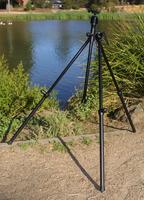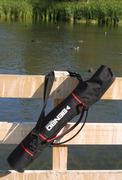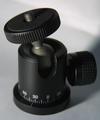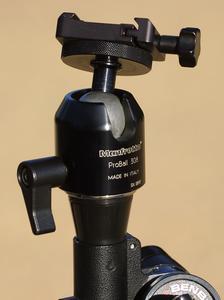


|

|
Subscribe to this site's News feed via RSS:
Our partners: |
Benbo Trekker tripod
David Burren 
In 2000 I purchased a Benbo Trekker tripod for use with my Nikon Coolpix 950. Today I often use the tripod with 35mm camera gear, although I have upgraded the ballhead that came with it. What attracted me to the Trekker was the combination of size, weight, and flexibility. 
It is easily carried (it even came with a nice bag to hang down your back)
which makes me more likely to actually take it into the field with me.
When I purchased it I was concerned that I didn't use a tripod enough and that
my photography might be suffering as a result, so this was important.
Occasionally I've had people think I had a rifle slung down my back, but
luckily it hasn't caused any real problem.
The legsThe Benbo has one control which loosens/tightens all three legs at the same time as the column, and then an extension/rotation control for each leg and for the column. The column can be completely flipped around (and locked at any point in-between) and has a 1/4" screw on each end. The legs are each made up of two sections. The lower sections are sealed with a plastic foot at the bottom and slide over the upper sections. Thus they can sit deep in water without any problem and when you collapse the legs it doesn't draw water up into the internals (I have no hesitation using the tripod in saltwater up to a foot or so deep). If the water level does go above the leg joint, water will enter the lower section, but the legs can be disassembled and cleaned (once you pull the foot off, the rest is straightforward). Because of the flexibility of the tripod's configuration (each of the legs has relatively independent movement) it is very good for macro work where you may need to get the camera into weird and wonderful positions. However it's not a very tall tripod - the camera's usually at around stomach height for me (I'm 6'4" tall). That's nowhere near eye-level, but you don't always need that. Taking photos of wildlife I'm often trying to be as inobtrusive as possible, which means I'm often sitting, squatting, or kneeling behind the tripod. StrengthObviously this tripod isn't sturdy enough to hold something like a 600mm/f4 lens, but for smaller loads it does great. As long as the ballhead is up to the task, that is. Here's an example of some of the gear that gets mounted on mine using a Manfrotto 308 ballhead:
Canon EOS D30 with BG-ED3 grip, 420EX flash with Better Beamer flash extender, 1.4xTC, 100-400mm IS lens. Benbo BallheadsThe ballhead that originally came with the tripod was quite basic, and after a while I upgraded to another ballhead from Benbo. I have since upgraded again as my 35mm gear is too large for those heads. I figured I'd write my notes about them down before I forget... 
First there's the original head: as you can see it's very basic. The mounting thread on the base is 1/4", and there's not much more to say. It has no pan function: to change the orientation of the "vertical slot" you have to rotate the tripod's column. This is easily done with the Trekker although a single knob tightens the column in both height and rotation: if the column is at all extended you need to hold it up to maintain the height while you rotate the column. Very clumsy - today this head's kicking around in my "parts bin". 
On the right is what Benbo calls the "Mini Ball & Socket Head". It has a suspicious similarity to the Giotto MH1003: it's probably a rebadge. Benbo lists the specifications as:
Again a single knob controls the head, but it will rotate around on its own base without having to manipulate the tripod. The knob has nice rubber knurling and is easy to lock down, the head's motion is smooth and fluid when "loose", and all in all it's quite nice to use. However I'm not so sure about the 4kg load rating, especially if the load is flopped over to the side. The way the internals of the head are designed, as you tighten the knob it pushs the ball up against the shell of the head, and under severe load it is possible for the shell to "pop" away from the base slightly. While it probably won't fall off, all locking is lost until you realign the internals and reassemble the head. The answer is simple: don't use more than a kilo or so of gear on this head. Within that restriction the Mini Ball & Socket Head is a nice head. Manfrotto 308 ballhead
Today I use a Manfrotto 308 ProBall head on this tripod. It's also rated at being able to carry 4kgs, but this time I believe it. It was a similar price to the Benbo Mini Ball & Socket Head, but is a much more solid affair. Again a single knob controls the head, but the internal design is one that pulls the shell down onto the ball when the knob is tightened. My main quibble with this head is that it has a tendency to pull to the right slightly when the knob is tightened. A slight pressure to hold the camera & lens in place when you tighten the head is enough to avoid the problem, but it's annoying nonetheless. You may notice I have the 308 head and not the 308RC (which has Manfrotto's QR clamp built-in). They're about the same price, but I have attached a QR-1 Arca-Swiss style clamp from Kirk Enterprises to mine. All of my gear (apart from my ancient Coolpix) now uses A-S plates and clamps, making it very easy to mount and release gear. While the 308's round camera platform will detach, the resulting screw is not a standard 3/8" type - otherwise I would have used a Kirk QR-8. Having a single knob controlling both the ball and the panning action is a drawback if you want to use something like the Wimberley Sidekick in the A-S clamp, but it's fine for general use. In any case you're not likely to use a Sidekick on a tripod of this size. ConclusionsThe Trekker is a small tripod, but when set up with a reasonable ballhead it is very capable, and for a quite reasonable price (including a head such as the 308). I plan to upgrade to a larger tripod at some point in the future, but for now the Trekker fits a niche in my equipment needs. June 2003I just noticed that the Manfrotto 308 head has been replaced by the 486, which is actually rated for heavier loads. Also it has two "vertical slots" (one on each side of the head). It seems like a nice unit. Also, here's an illustration of one of the ways in which the Benbo design is so flexible. I was photographing the tiny blossoms amongst the grass:
October 2003 - The "Trekker 2"
Apparently the Benbo Trekker is no longer available. The current model is the "Trekker 2" (as can be seen on the Paterson Photographic web site - the image to the right is linked directly from there). Unlike the larger Benbo tripods and the original Trekker, the new version does not have a simple threaded mount at each end of the column. One end just has a hook for hanging a bag from for "added stability" (only useful when the column is vertical) and the other has a plastic swivel joint below the head mount point. I have been told by users of the Trekker 2 that the swivel joint adds quite a bit of instability (with a small digicam you may not notice, but with a heavier SLR you probably will). I don't understand why Benbo would add this when a decent ball head offers more flexibility and greater stability (admittedly I sometimes end up with my camera hanging upside down, but it hasn't stopped me taking a photo yet). Another benefit of the symmetrical column (you can mount the head on either end) of the original Trekker is that you can set up the tripod's main clamp for either left or right-handed operation. This is not a major point, but it has come in handy for me once or twice. By the way, on my Trekker I currently have the Manfrotto 308 head with Arca-Swiss clamp on one end, and the Benbo Mini Ball & Socket Head (i.e. Giotto MH1003) on the other (for use with remote flashes and with small cameras without A-S plates). The flexibility of this arrangement would be lost with the new Trekker.
Unfortunately here seems to be no way to remove the swivel joint and restore
stability.
I would hesitate to purchase a Trekker 2 for this reason, but you'll have
to make up your own mind as to whether it's a show-stopper for you.
| ||||||||||||||||||||||||||||||
|
Unless otherwise noted, all text and images on this website are Copyright David Burren Photography 2000-2010 and may not be used for any purpose without prior consent.
| |||||||||||||||||||||||||||||||